英语中的形容词
英语形容词分类总结归纳表

英语形容词可以根据其所描述的对象进行分类,以下是一些常见的分类:
1. 描述人的特征:
-年龄:young, old, young, elderly
-性别:male, female, male, female
-外貌:tall, short, fat, thin, beautiful, ugly
-性格:kind, cruel, honest, dishonest, brave, cowardly
-能力:smart, stupid, talented, untalented, capable, incapable
2. 描述物的特征:
-大小:big, small, large, tiny
-形状:round, square, long, short
-颜色:red, blue, green, black, white
-材质:soft, hard, rough, smooth
-状态:new, old, broken, fixed
3. 描述情感或感觉的形容词:
-快乐:happy, sad, excited, bored
-疼痛:painful, comfortable
-味道:sweet, sour, bitter, salty
-声音:loud, quiet
-温度:hot, cold
4. 描述时间或地点的形容词:
-时间:past, present, future
-地点:here, there, near, far
5. 描述数量或程度的形容词:
-数量:many, few, much, little
-程度:very, extremely, quite, slightly。
英语作文常用形容词
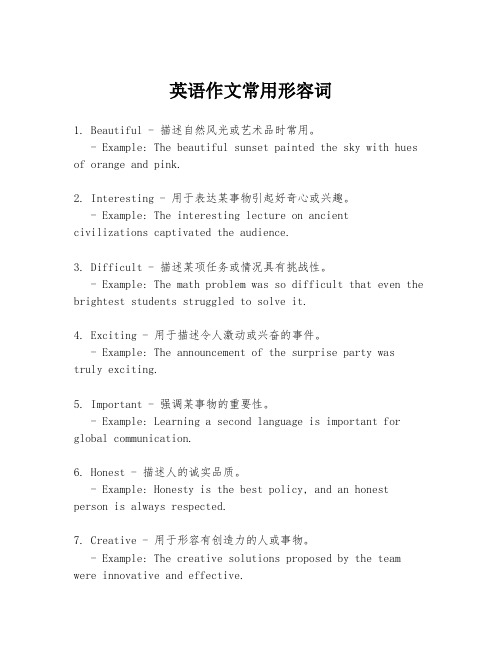
英语作文常用形容词1. Beautiful - 描述自然风光或艺术品时常用。
- Example: The beautiful sunset painted the sky with hues of orange and pink.2. Interesting - 用于表达某事物引起好奇心或兴趣。
- Example: The interesting lecture on ancientcivilizations captivated the audience.3. Difficult - 描述某项任务或情况具有挑战性。
- Example: The math problem was so difficult that even the brightest students struggled to solve it.4. Exciting - 用于描述令人激动或兴奋的事件。
- Example: The announcement of the surprise party wastruly exciting.5. Important - 强调某事物的重要性。
- Example: Learning a second language is important for global communication.6. Honest - 描述人的诚实品质。
- Example: Honesty is the best policy, and an honest person is always respected.7. Creative - 用于形容有创造力的人或事物。
- Example: The creative solutions proposed by the team were innovative and effective.8. Happy - 描述快乐的情绪或情境。
- Example: The children were happy to see their grandparents after a long time.9. Sad - 表达悲伤或失望的情感。
英语形容词定义

英语形容词定义一、形容词的定义在人教版英语教材中,形容词(adjective)是用来描述或修饰名词(或代词),表示人或事物的性质、特征、状态等的词类。
例如:1. “a beautiful flower”(一朵美丽的花),“beautiful”(美丽的)就是形容词,它描述了“flower”(花)的特征。
2. “He is a tall boy.”(他是一个高个子男孩),“tall”(高的)这个形容词描述了“boy”(男孩)的状态(身高方面的状态)。
形容词在句子中可以作定语、表语、宾语补足语等成分。
1. 作定语- 一般放在被修饰的名词之前,如“a big apple”(一个大苹果),“big”修饰“apple”,说明苹果的大小这一特征。
- 当有多个形容词修饰一个名词时,有一定的顺序,一般遵循“限定词(如a/an/the等)+描绘性形容词(如beautiful, nice等)+大小+形状+年龄+颜色+国籍+材料+用途+名词”的顺序,例如“a beautiful small old red Chinese wooden writing desk”(一张漂亮的、小的、旧的、红色的中国木制写字台)。
2. 作表语- 位于系动词(如be动词am/is/are,感官动词look, sound, feel等)之后,用来描述主语的性质、状态等。
例如:The weather is cold.(天气很冷。
)“cold”作表语,描述“weather”(天气)的状态。
3. 作宾语补足语- 用来补充说明宾语的性质、状态等。
例如:We made the room clean.(我们使房间干净了。
)“clean”补充说明“room”(房间)的状态,是宾语“room”的补足语。
英语赞美人的形容词
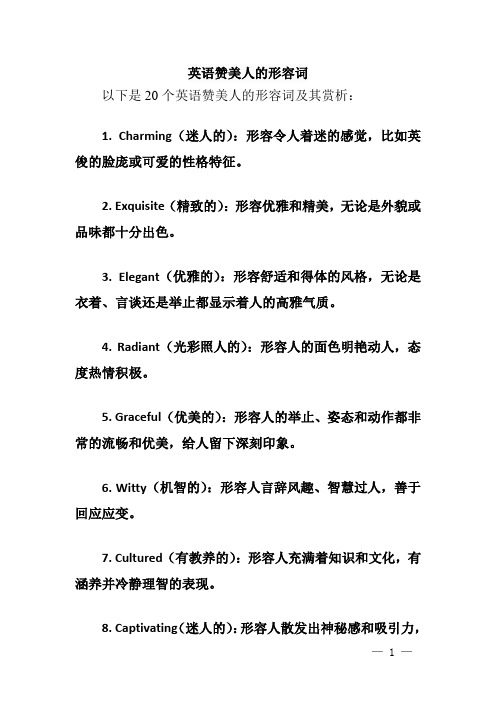
英语赞美人的形容词以下是20个英语赞美人的形容词及其赏析:1. Charming(迷人的):形容令人着迷的感觉,比如英俊的脸庞或可爱的性格特征。
2. Exquisite(精致的):形容优雅和精美,无论是外貌或品味都十分出色。
3. Elegant(优雅的):形容舒适和得体的风格,无论是衣着、言谈还是举止都显示着人的高雅气质。
4. Radiant(光彩照人的):形容人的面色明艳动人,态度热情积极。
5. Graceful(优美的):形容人的举止、姿态和动作都非常的流畅和优美,给人留下深刻印象。
6. Witty(机智的):形容人言辞风趣、智慧过人,善于回应应变。
7. Cultured(有教养的):形容人充满着知识和文化,有涵养并冷静理智的表现。
8. Captivating(迷人的):形容人散发出神秘感和吸引力,— 1 —令人陶醉。
9. Charismatic(魅力的):形容人拥有非常强烈的魅力,令人信服和欣赏。
10. Sophisticated(世故的):形容人明智、有见识,懂得处理各种情况和人际关系。
11. Intellectual(智力的):形容人聪明机智、有智力,能够理性而高效地思考问题。
12. Kind-hearted(善良的):形容人非常善良,能够同情、感悟和关爱别人。
13. Gracious(亲切的):形容人和蔼可亲、亲切友善,非常具有人情味,注意礼节。
14. Confident(自信的):形容人自信、有自尊、有勇气,在工作或生活中表现强烈的信心。
15. Independent(独立的):形容人冷静、有独立的精神、有自我管理能力,值得赞扬。
16. Passionate(充满热情的):形容人有强烈的内心火— 2 —焰和利害关系,对事业或生活有热情与追求。
17. Noble(高贵的):形容人有理想、信仰、正义感、胸怀和追求,充满高尚精神。
18. Honorable(尊贵的):形容人光荣、尊贵、有崇高的地位和品质,非常值得称赞。
英语形容词分类大全
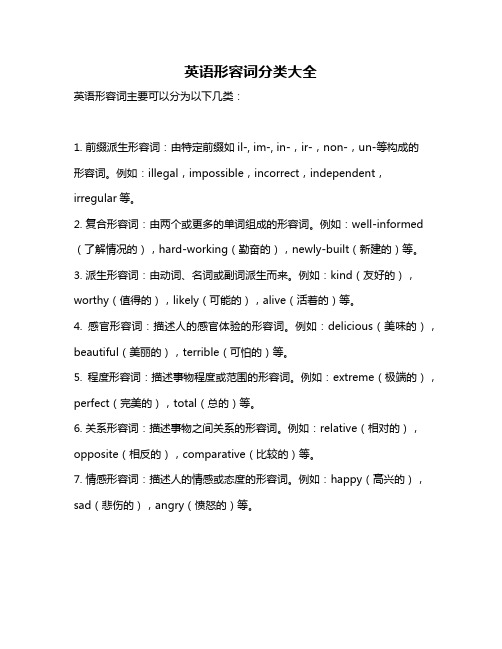
英语形容词分类大全英语形容词主要可以分为以下几类:1. 前缀派生形容词:由特定前缀如il-, im-, in-,ir-,non-,un-等构成的形容词。
例如:illegal,impossible,incorrect,independent,irregular等。
2. 复合形容词:由两个或更多的单词组成的形容词。
例如:well-informed (了解情况的),hard-working(勤奋的),newly-built(新建的)等。
3. 派生形容词:由动词、名词或副词派生而来。
例如:kind(友好的),worthy(值得的),likely(可能的),alive(活着的)等。
4. 感官形容词:描述人的感官体验的形容词。
例如:delicious(美味的),beautiful(美丽的),terrible(可怕的)等。
5. 程度形容词:描述事物程度或范围的形容词。
例如:extreme(极端的),perfect(完美的),total(总的)等。
6. 关系形容词:描述事物之间关系的形容词。
例如:relative(相对的),opposite(相反的),comparative(比较的)等。
7. 情感形容词:描述人的情感或态度的形容词。
例如:happy(高兴的),sad(悲伤的),angry(愤怒的)等。
8. 表示国籍、地区、时间等的形容词:例如:Australian(澳大利亚的),European(欧洲的),Canadian(加拿大的);day(白天的),night (夜晚的);old(老的),young(年轻的)等。
9. 指示代词和不定代词修饰的形容词:例如:this(这个), that(那个), these(这些), those(那些);some(一些), other(其他的), any (任何的)等。
10. 序数词和基数词修饰的形容词:例如:first(第一), last(最后);second(第二), third(第三)等。
英语形容词分类归纳

形容词的基本分类形容词是一种用来描述或修饰名词或代词的词汇。
根据其修饰的名词的性质和特点,我们可以将形容词分为以下几个基本分类:1. 描述性形容词(Descriptive Adjectives):描述性形容词用来描述名词的外貌、颜色、大小、形状、质地等特征。
例如,"beautiful"(美丽的)、"red"(红色的)、"large"(大的)等。
2. 定量形容词(Quantitative Adjectives):定量形容词用来表示数量或程度。
它们可以是具体数字或表示范围的词汇。
例如,"one"(一个)、"few"(几个)、"many"(许多)、"much"(很多)、"little"(少量的)等。
3. 比较级形容词(Comparative Adjectives):比较级形容词用来比较两个或多个事物的性质或程度。
它们通常在词尾加上 "-er" 或者在前面加上 "more" 来表示比较级。
例如,"bigger"(更大的)、"more beautiful"(更美丽的)等。
4. 最高级形容词(Superlative Adjectives):最高级形容词用来表示三个或三个以上事物中最高程度的性质或特征。
它们通常在词尾加上 "-est" 或者在前面加上 "most" 来表示最高级。
例如,"biggest"(最大的)、"most beautiful"(最美丽的)等。
5. 限定性形容词(Limiting Adjectives):限定性形容词用来限定名词的范围或数量,它们通常指示名词的特定身份、归属或数量。
英语形容词
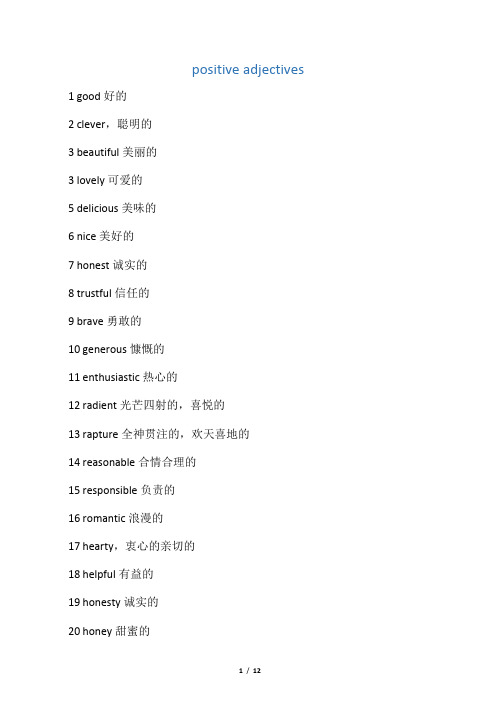
positive adjectives1 good好的2 clever,聪明的3 beautiful美丽的3 lovely可爱的5 delicious美味的6 nice美好的7 honest诚实的8 trustful信任的9 brave勇敢的10 generous慷慨的11 enthusiastic热心的12 radient光芒四射的,喜悦的13 rapture全神贯注的,欢天喜地的14 reasonable合情合理的15 responsible负责的16 romantic浪漫的17 hearty,衷心的亲切的18 helpful有益的19 honesty诚实的20 honey甜蜜的21 humor幽默的bright辉煌的22 useful有用的23 Brilliant英明的24 United和睦的25 beautiful美丽的26 smart灵巧的27 obedient,服从的28 objective,客观的29 obliging,乐于助人的,礼貌的30 diligent勤奋的negative adjectives1 bad2 cunning狡诈的3 dishonest不诚实的4 money-minded爱钱如命的5 evil恶毒的6 narrow-minded7 blinkered目光狭窄的8 faceless无个性的9 jump-up妄自尊大的10 greedy贪心的11 corrupt贪污的12 violent血腥的13 hateful可恶的14 unholiness邪恶的15 careless粗心大意的16 calculating工于心计的17 coward胆小鬼,懦夫18 cozy互相勾结的19 cold-blooded无情的20 cold-hearted铁石心肠的21 crappy差劲的,不好的22 crazy疯癫的,愚蠢的23 cruel残忍的24 crummy劣质的25 crusty暴躁的26 critical吹毛求疵的,爱挑剔的27 cynical愤世嫉俗的,冷嘲热讽的28 crude粗鲁,粗俗的29 cuckoo疯疯癫癫的,傻的30 brutal冷酷的able有才干的,能干的active主动的,活跃的adaptable适应性强的adroit灵巧的,机敏的aggressive有进取心的alert机灵的ambitious有雄心壮志的amiable和蔼可亲的amicable友好的analytical善于分析的apprehensive有理解力的aspiring有志气的,有抱负的audacious大胆的,有冒险精神的capable有能力的,有才能的careful办事仔细的candid正直的charitable宽厚的competent能胜任的confident有信心的conscientious认真的,自觉的considerate体贴的constructive建设性的contemplative好沉思的cooperative有合作精神的creative富创造力的dashing有一股子冲劲的,有拼搏精神的dedicated有奉献精神的devoted有献身精神的dependable可靠的diplomatic老练的,有策略的disciplined守纪律的discreet(在行动,说话等方面)谨慎的来源:个人求职简历dutiful尽职的dynamic精悍的earnest认真的well-educated受过良好教育的efficient有效率的energetic精力充沛的enthusiastic充满热情的expressive善于表达faithful守信的,忠诚的forceful(性格)坚强的frank直率的,真诚的friendly友好的frugal俭朴的generous宽宏大量的genteel有教养的gentle有礼貌的hard-working勤劳的hearty精神饱满的honest诚实的hospitable殷勤的humble恭顺的humorous幽默的impartial公正的independent有主见的industrious勤奋的ingenious有独创性的initiative首创精神have an inquiring mind爱动脑筋intellective有智力的intelligent理解力强的inventive有发明才能的,有创造力的just正直的kind-hearted好心的knowledgeable有见识的learned精通某门学问的liberal心胸宽大的logical条理分明的loyal忠心耿耿的methodical有方法的modest谦虚的motivated目的明确的objective客观的open-minded虚心的orderly守纪律的original有独创性的painstaking辛勤的,苦干的,刻苦的practical实际的precise一丝不苟的persevering不屈不挠的punctual严守时刻的purposeful意志坚强的qualified合格的rational有理性的realistic实事求是的reasonable讲道理的reliable可信赖的responsible负责的self-conscious自觉的selfless无私的sensible明白事理的sincere真诚的smart精明的spirited生气勃勃的sporting光明正大的steady塌实的straightforward老实的strict严格的systematic有系统的strong-willed意志坚强的sweet-tempered性情温和的temperate稳健的tireless孜孜不倦的good weather:sunny /finenice/lovely/glorious:天气非常好,阳光充足bright:阳光明媚;光芒四射there isn't a cloud in the sky:天空晴朗dry:天气干燥的,不下雨的fair:晴朗的(无风无雨),常用于天气预报rain: wet/rainy/damp多雨的unsettled:天气多变的(常下雨)drizzle:细雨,毛毛雨shower:阵雨downpour:倾盆大雨,暴雨it'spouringdown(BritishEnglish)/it'spouring rain(American English)下着瓢泼大雨it's drizzling:下着毛毛细雨snow: snowy多雪的sleet:雨夹雪slush:雪泥;部分融化了的雪和冰混合物hail/hailstones:冰雹blizzard:暴风雪frost:霜wind: windy刮风的,多风的blustery:风特别大的breeze:微风,和风(breezeanddrizzle和风细雨)hurricane(intheAtlanticOcean)/typhoon(inthe Pacific Ocean):飓风(大西洋)/台风(太平洋)cloudy:多云的grey/dull:灰蒙蒙的;阴沉的overcast:多云的,阴沉的(要下雨)hazy:烟雾弥漫的,雾蒙蒙的hot:boiling/scorching/sizzling/blazing/burning/baking/broiling(hot)都表示“非常热”sweltering闷热的,湿热的warm暖和的balmy温和的,和煦的heatwave热浪;酷暑期cold: freezing (cold)特别寒冷arctic极为寒冷的(常常冰天雪地)wintry严寒的,像冬天的crisp清新的,干冷的chilly比较冷(让人感觉不舒服)cool凉快的;凉爽的cold snap/cold spell寒流/春寒1)用作定语,修饰名词。
英语常用200个形容人的形容词
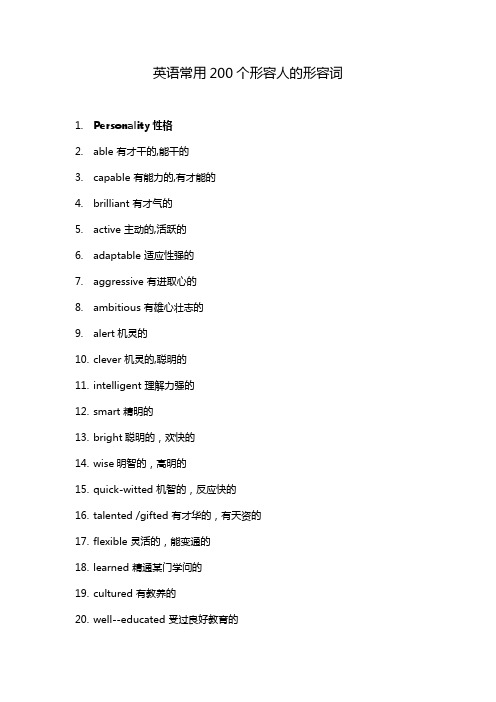
英语常用200个形容人的形容词1.Personality 性格2.able 有才干的,能干的3.capable 有能力的,有才能的4.brilliant 有才气的5.active 主动的,活跃的6.adaptable 适应性强的7.aggressive 有进取心的8.ambitious 有雄心壮志的9.alert 机灵的10.clever 机灵的,聪明的11.intelligent 理解力强的12.smart 精明的13.bright聪明的,欢快的14.wise明智的,高明的15.quick-witted 机智的,反应快的16.talented /gifted 有才华的,有天资的17.flexible 灵活的,能变通的18.learned 精通某门学问的19.cultured 有教养的20.well--educated 受过良好教育的21.knowledgeable 有见识的22.diplomatic 老练的,有策略的23.resourceful 深谋远虑的/足智多谋的24.attractive 有魅力的25.brave 勇敢的26.courageous 勇敢的,有胆量的27.careful 办事仔细的28.careless 粗心大意的29.earnest 认真的30.caring 有同情心的31.calm冷静的32.confident 有信心的33.conscientious 认真的,勤勤恳恳的,凭良心的34.considerate 体贴的35.inconsiderate 不顾及别人的,轻率的36.constructive 建设性的37.cooperative 有合作精神的38.creative 富创造力的39.ingenious 有独创性的40.initiative 首创精神41.inventive 有发明才能的,有创造力的42.original 有独创性的43.dashing 有一股子冲劲的,有拼搏精神的44.dedicated 有奉献精神的45.demanding 苛刻的,要求高的,费时费力的46.efficient 有效率的47.energetic 精力充沛的48.enthusiastic 充满热情的49.expressive 善于表达50.emotional 感性的51.forceful (性格)坚强的52.tough坚强的;健壮的;能吃苦耐劳的;坚韧不拔的53.purposeful 意志坚强的54.motivated 目的明确的,有动机的,积极主动的55.objective 客观的56.subjective主观的57.optimistic 乐观的58.pessimistic悲观的59.positive 积极的, 乐观的60.negative消极的;负面的;缺乏热情的61.frank 直率的,真诚的62.honest 诚实的(dishonest)63.just 正直的64.faithful 守信的,忠诚的65.loyal 忠心耿耿的66.straightforward 诚恳的67.generous 宽宏大量的68.greedy贪婪的69.mean 吝啬的zy 懒惰的,懒散的71.moody 情绪化的72.mysterious 神秘的,难懂的73.argumentative 好争辩的74.bad-tempered 脾气暴燥的75.bigmouth 多嘴多舌的76.talkative多话的77.noisy 聒噪的78.forgetful 健忘的79.dull /boring无趣80.cool不友好的;冷淡的;冷漠的81.shy害羞的82.hard-working 勤劳的83.industrious 勤奋的84.painstaking 辛勤的,苦干的,刻苦的85.diligent 勤奋的86.have an inquiring mind 爱动脑筋的87.helpful 助人的,有益的passionate 有爱心的89.helpless 无助的,没用的90.hopeful满怀希望的,有前途的91.promising有希望的,有前途的92.forward-looking 有远见的93.hospitable 殷勤的,好客的94.kind 仁慈的,和蔼的(unkind)95.kind-hearted 好心的96.materialistic 过于现实的97.precise 一丝不苟的98.punctual 严守时刻的99.pushy 有进取心的100.qualified 合格的101.rational 有理性的102.realistic 实事求是的103.reasonable 讲道理的104.responsible 负责的105.romantic 浪漫的,空想的106.self-conscious 自觉的107.self-disciplined自律的108.self-centered 自我为中心109.selfish 自私的110.selfless 无私的111.sensible 明白事理的112.sensitive 敏感的113.sincere 真诚的114.insincere 表里不一115.sociable 好交际的116.independent独立的,有主见的117.dependable 可靠的118.reliable 可信赖的119.unreliable不可靠的120.trustworthy 可信赖的121.respectable体面的;得体的;值得尊敬的122.respected受人尊敬的,德高望重123.economical节俭的,精打细算的124.strict严格的125.strong-willed/tough-minded意志坚强的126.absent-minded心不在焉的127.tireless孜孜不倦的128.persevering不屈不挠的129.persistent执著的;不屈不挠的;坚持不懈的130.Appearance外表描述身材131.well-built体态健美的,体格健美的132.(of) medium/average height/build中等身高133.fat 肥胖的(较贬义)134.overweight(较客气的)135.plump 丰满的136.chubby 胖乎乎很可爱(形容小孩)137.slim 苗条的138.shapely 身材匀称的139.thin瘦的140.lean 瘦削的141.skinny极瘦的,皮包骨的142.short and stout 矮胖143.My brother is tall and well-built. 我的弟弟长得高,且身材匀称。
常用英语形容词词汇

常用英语形容词词汇常用英语形容词词汇汇总形容词是词类的一种,主要用来描写或修饰名词或代词,表示人或事物的性质、状态、特征或属性,常用作定语,也可作表语或补语。
以下是店铺帮大家整理的常用英语形容词词汇汇总,希望能够帮助到大家。
good(好的)bad(坏的)small(小的)big(大的)hugry(饿的)full(饱的)little(少的)high(高的)short(矮的,短的)tall(高的)long(长的)old(老的,旧的)new(新的)young(年轻的)many(许多的)much(许多的)beautiful(漂亮的)nice(美好的)early(早的)late(迟的)right(正确的)wrong(错误的)busy(忙的)lazy(懒的)bored(无聊的)heavy(重的)light(轻的)blind(盲的)kind(善良的)happy(高兴的)sad(伤心的)fast(快的)fun(有趣的)scary(吓人的)different(不同的)same(同样的)round(圆的)great(伟大的)颜色:black(黑的)white(白的)blue(蓝的)purple(紫的)pink(粉的)yellow(黄的)orange(桔黄的)green(绿的) brown(棕色的)grey(灰的)gold(金色的)天气:sunny(晴朗的)cloudy(多云的)snowy(多雪的)able有才干的,能干的active主动的,活跃的(torpidity,active的反义词)adaptable适应性强的(inadaptable,adaptable的反义词)adroit灵巧的,机敏的(clumsy,adroit的反义词)aggressive有进取心的(ingressive,aggressive的反义词)alert机灵的ambitious有雄心壮志的amiable和蔼可亲的amicable友好的analytical善于分析的apprehensive有理解力的aspiring有志气的,有抱负的audacious大胆的,有冒险精神的capable有能力的,有才能的careful办事仔细的.(careless,careful的反义词)candid正直的(unjust,candid的反义词)charitable宽厚的competent能胜任的confident有信心的(diffident,confident的反义词)conscientious认真的,自觉的considerate体贴的constructive建设性的contemplative好沉思的cooperative有合作精神的creative富创造力的cute可爱的dashing有一股子冲劲的,有拼搏精神的dedicated有奉献精神的devoted有献身精神的dependable可靠的diplomatic老练的,有策略的disciplined守纪律的discreet(在行动,说话等方面)谨慎的dutiful尽职的dynamic精悍的earnest认真的well-educated受过良好教育的efficient有效率的energetic精力充沛的enthusiastic充满热情的expressive善于表达faithful守信的,忠诚的forceful(性格)坚强的frank直率的,真诚的friendly友好的frugal俭朴的good好的generous宽宏大量的genteel有教养的gentle有礼貌的handsome英俊的hard-working勤劳的hearty精神饱满的honest诚实的hospitable殷勤的humble恭顺的humorous幽默的impartial公正的independent有主见的industrious勤奋的ingenious有独创性的initiative首创精神haveaninquiringmind爱动脑筋hardworking勤奋的intellective有智力的intelligent理解力强的inventive有发明才能的,有创造力的just正直的kind-hearted好心的knowledgeable有见识的learned精通某门学问的liberal心胸宽大的logical条理分明的loyal忠心耿耿的methodical有方法的modest谦虚的motivated目的明确的negative消极的objective客观的open-minded虚心的orderly守纪律的original有独创性的painstaking辛勤的,苦干的,刻苦的practical实际的precise一丝不苟的【常用英语形容词词汇汇总】。
小学英语单词之形容词
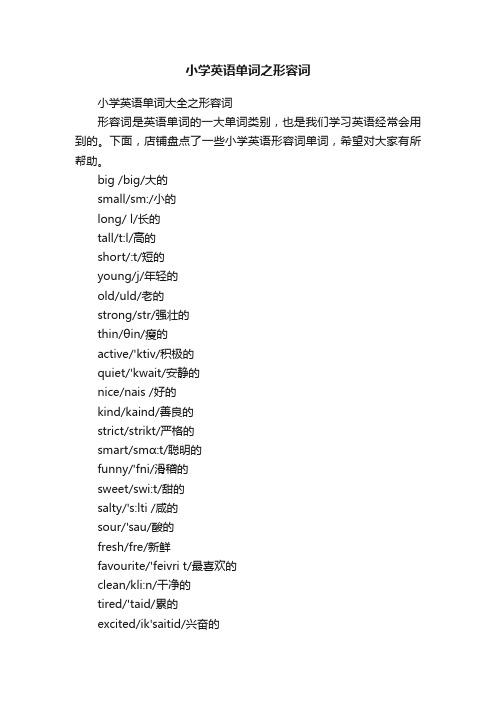
小学英语单词之形容词小学英语单词大全之形容词形容词是英语单词的一大单词类别,也是我们学习英语经常会用到的。
下面,店铺盘点了一些小学英语形容词单词,希望对大家有所帮助。
big /big/大的small/sm:/小的long/ l/长的tall/t:l/高的short/:t/短的young/j/年轻的old/uld/老的strong/str/强壮的thin/θin/瘦的active/'ktiv/积极的quiet/'kwait/安静的nice/nais /好的kind/kaind/善良的strict/strikt/严格的smart/smɑ:t/聪明的funny/'fni/滑稽的sweet/swi:t/甜的salty/'s:lti /咸的sour/'sau/酸的fresh/fre/新鲜favourite/'feivri t/最喜欢的clean/kli:n/干净的tired/'taid/累的excited/ik'saitid/兴奋的angry/'gri/生气的happy/'hpi/高兴的bored/b:d/无聊的sad/sd/难过的taller更高的shorter更短的stronger更强壮的older更老的younger更年轻的bigger更大的heavier更重的longer 更长的thinner更瘦的smaller更小的 good好的better更好的higher更高的fine/fain/好的great/greit/棒的heavy/'hevi/重的new/nju:/新的fat/ft/胖的right /rait/对的hungry/'hgri/饿的cute/kju:t/可爱的little/'litl/小的lovely/'lvli/可爱的beautiful/'bju:tfl/漂亮的colourful/'klful/五颜六色的pretty/'priti/漂亮的cheap/ti:p/便宜的expensive/iks'pensiv/贵的juicy/'du:si/有汁的healthy/'helθi/健康的helpful/'helpfl /有帮助的high/hai/高的easy/'i:zi/简单的proud/praud/骄傲的PEP小学英语单词总汇PEP英语三年级(上册)三会单词Unit 1pen 钢笔 pencil 铅笔 pencil-case 铅笔盒 ruler 尺子 eraser 橡皮crayon 蜡笔book 书 bag 书包 sharpener 卷笔刀 school 学校Unit 2head 头face 脸nose 鼻子mouth 嘴eye 眼睛ear 耳朵arm 胳膊finger 手指 leg腿foot 脚body 身体Unit3red 红色的yellow 黄色的green 绿色的blue 蓝色的 purple 紫色的white 白色的black 黑色的orange 橙色的pink 粉色的brown 棕色的Unit 4cat 猫dog 狗monkey 猴子panda 熊猫rabbit 兔子duck 鸭子pig 猪bird 鸟bear 熊elephant 大象mouse 老鼠squirrel 松鼠Unit 5cake 蛋糕bread 面包hot dog 热狗hamburger 汉堡包chicken 鸡肉French fries 榨薯条Coke 可乐juice 果汁milk 牛奶water 水tea 茶coffee 咖啡Unit 6one 一two 二three 三four 四five 五six 六seven 七eight 八nine 九ten 十doll 玩具娃娃boat 小船ball 球kite 风筝balloon 气球car 小汽车plane 飞机PEP英语三年级(下册)三会单词Unit 1boy 男孩 girl 女孩teacher 教师student 学生this 这个my 我的friend 朋友I’m=I am 我是nice 好的;愉快的good morning 早上好good afternoon 下午好meet 遇见;碰见goodbye 再见too 也;太Unit 2father 父亲;爸爸dad 爸爸(口语)mother 母亲;妈妈mom 妈妈(口语)man男人woman 女人grandmother (外)祖母grandma (口语)(外)祖母grandfather (外)祖父grandpa (口语)(外)祖父sister 姐妹brother 兄弟let’s=let us让我们great 太好了really 真地;确切地and 和;并且how 多么;怎么样Unit 3eleven 十一twelve 十二thirteen 十三fourteen 十四fifteen 十五sixteen 十六seventeen 十七eighteen 十八nineteen 十九twenty 二十how many 多少can 能够;可以look at 看;瞧Unit 4peach 桃pear 梨orange 橙子watermelon 西瓜apple 苹果banana 香蕉strawberry 草莓grape 葡萄like 喜欢some 一些;某些thanks 多谢Unit 5bus 公共汽车bike 自行车taxi 出租车jeep 吉普车desk 课桌chair 椅子walkman 随身听lamp 台灯your 你的;你们的zoo 动物园Unit 6small 小的big 大的long 长的short 短的;矮的tall 高的giraffe 长颈鹿deer 鹿PEP四年级上册四会单词词汇表Unit 1Window(窗户) board(板) light(灯) picture(图片) door(门) floor(地板) classroom (教室) computer(电脑) teacher’desk(讲台) wall(墙) fan(扇子)Unit 2bag(包) pencil(铅笔) pen(钢笔) book (书) ruler(尺子) pencil-case(铅笔盒)Unit 3teacher(教师) student(学生) boy(男孩) girl(女孩) friend(朋友) Unit 4home(家) room(房间) school(学校) classroom(教室)window(窗户) desk(课桌;书桌) door(门) chair(椅子) bed(床) Unit 5rice(米饭) beef(牛肉) bread(面包) milk(牛奶) egg(蛋)watter(水) chicken(鸡肉) fish(鱼)Unit 6sister(姐妹) brother(兄弟) father(父亲;爸爸) mother(母亲;妈妈)driver(司机) doctor(医生) farmer(农民) nurse(护士)PEP四年级下册四会单词词汇表Unit 1computer(计算机) board(写字板) fan(风扇) light(灯)this(这;这个) is(是)my(我的) that(那;那个) your(你的)teacher’s desk(讲台) picture(图画;照片) wall(墙壁) floor(地板) yes(是;是的) it(它)Unit 2one(一) two(二) three(三) four(四) five(五) six(六) seven(七) eight(八) nine(九) ten(十) what(什么) time(时间)it’s=it is …o’clock(…点钟) math(数学) Chinese(语文) English(英语) P.E.(体育) music(音乐) for(为;给) class(课程)关于动物的小学英语单词大全动物(animals)猫cat狗dog猪pig鸭duck兔rabbit马horse大象elephant蚂蚁ant鱼fish鹰eagle鹿deer海狸beaver鸟bird蛇snake老鼠mouse松鼠squirrel熊bear袋鼠kangaroo猴monkey熊猫panda狮子lion老虎tiger狐狸fox斑马zebra长颈鹿giraffe鹅goose母鸡hen火鸡turkey小羊lamb绵羊sheep山羊goat奶牛cow驴donkey鱿鱼squid龙虾lobster鲨鱼shark海豹seal抹香鲸sperm whale虎鲸killer whale小学英语单词记忆方法有哪些1、观察记忆法利用这种方法在初次接触单词时可以通过巧妙观察很快记住单词。
英语中的形容词有哪些比较级和最高级

英语中的形容词有哪些比较级和最高级?英语中的形容词比较级和最高级通常是通过在形容词前加上不同的前缀来构成的。
以下是常见的形容词比较级和最高级形式:1. 一般形式:形容词的原级(Positive Degree)是形容词的基本形式,用于描述事物的基本特征。
例如:big(大)、beautiful(美丽)、fast(快)等。
2. 比较级(Comparative Degree):用于比较两个事物的性质、大小、品质等。
形成比较级的一般规则是在形容词前加上"-er"或者在形容词前加上"more"。
例如:- big(大)- bigger(更大)- beautiful(美丽)- more beautiful(更美丽)- fast(快)- faster(更快)3. 最高级(Superlative Degree):用于比较三个或更多事物之间的性质、大小、品质等,表示最高程度。
形成最高级的一般规则是在形容词前加上"-est"或者在形容词前加上"most"。
例如:- big(大)- biggest(最大)- beautiful(美丽)- most beautiful(最美丽)- fast(快)- fastest(最快)需要注意的是,有些形容词的比较级和最高级形式是不规则的,需要记住其特殊形式。
例如:- good(好)- better(更好)- best(最好)- bad(坏)- worse(更坏)- worst(最坏)- much(多)- more(更多)- most(最多)以上是英语中常见的形容词比较级和最高级形式。
掌握这些形式可以帮助我们在表达时更准确地描述事物的特征和进行比较。
大学英语四级高频形容词表

大学英语四级高频形容词表1. Positive Adjectives(积极的形容词)- confident (自信的)- enthusiastic (热情的)- diligent (勤奋的)- reliable (可靠的)- intelligent (聪明的)- creative (有创造力的)- optimistic (乐观的)- passionate (充满激情的)- adaptable (适应能力强的)- resourceful (足智多谋的)2. Negative Adjectives(消极的形容词)- lazy (懒惰的)- arrogant (傲慢的)- careless (粗心大意的)- ignorant (无知的)- pessimistic (悲观的)- inconsistent (不一致的)- impatient (不耐烦的)- unreliable (靠不住的)- intolerant (不容忍的)- indecisive (优柔寡断的)3. Neutral Adjectives(中性的形容词)- average (平均的)- normal (正常的)- regular (常规的)- formal (正式的)- practical (实用的)- sincere (真诚的)- flexible (灵活的)- responsible (负责任的)- reasonable (合理的)以上是大学英语四级高频形容词表的完整版,这些形容词在四级英语考试中经常出现并常用于描述人、事、物的特征和属性。
熟悉并正确使用这些形容词,将有助于提升英语写作和口语表达的准确性和丰富性。
英语中的形容词

一、形容词概念定义:说明事物或人的性质或特征的词。
二、形容词构词法加后缀:比如-ly(friendly,lovely,lonely,lively,ugly,brotherly),-ful(helpful, hopeful, useful, careful),-ern(western, eatern),-y(windy, rainy, furry,sunny, snowy, noisy)还有比如-ese, -ian等合成:two-week, eight-year-old等等三、形容词功能。
1.做定语,a, 放在所修饰的名词之前,头发:长短,曲直,颜色, long straight blackhair。
普通名词:大小,形状,新旧,颜色,国籍,材料,a big round new yellow Chinesewood table.b, 放在所修饰词之后的,如合成不定代词,some-,no-,any 和every-+-thing,-body,和放在量词之后,He is one metres tall.和else 修饰疑问代词时c, 表示位置、次序的形容词left 左边的right 右边的elder 年长的,latter 后者的;表示某种材料的形容词,golden 金的,wooden 木制的2. 作表语。
A, 只能做表语的形容词,afraid, alone,asleep, alive, well, ill, alike, awake等(正)Don’t be afraid.(误)Mr Li is an afraid man.(正)The old man was ill yesterday.(误)This is an ill person.B, 感动系动词+adj, feel, sound, smell, taste, lookC, 表示使、变的get wet, become good,turn red, grow big等。
英语高级词汇形容词
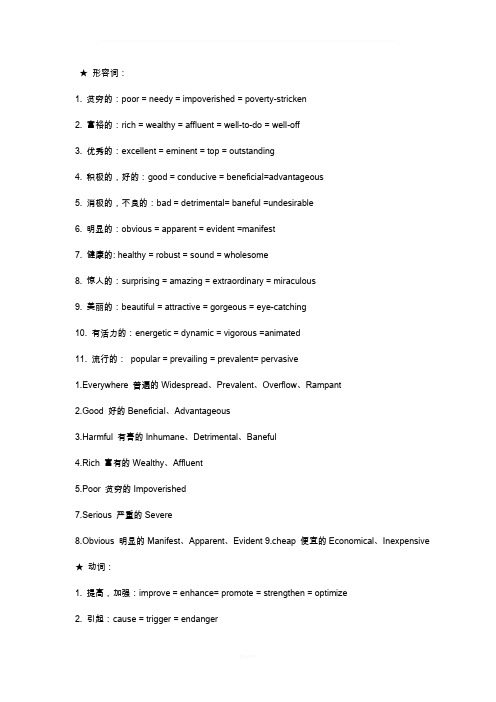
★形容词:1. 贫穷的:poor = needy = impoverished = poverty-stricken2. 富裕的:rich = wealthy = affluent = well-to-do = well-off3. 优秀的:excellent = eminent = top = outstanding4. 积极的,好的:good = conducive = beneficial=advantageous5. 消极的,不良的:bad = detrimental= baneful =undesirable6. 明显的:obvious = apparent = evident =manifest7. 健康的: healthy = robust = sound = wholesome8. 惊人的:surprising = amazing = extraordinary = miraculous9. 美丽的:beautiful = attractive = gorgeous = eye-catching10. 有活力的:energetic = dynamic = vigorous =animated11. 流行的:popular = prevailing = prevalent= pervasive1.Everywhere 普遍的Widespread、Prevalent、Overflow、Rampant2.Good 好的Beneficial、Advantageous3.Harmful 有害的Inhumane、Detrimental、Baneful4.Rich 富有的Wealthy、Affluent5.Poor 贫穷的Impoverished7.Serious 严重的Severe8.Obvious 明显的Manifest、Apparent、Evident 9.cheap 便宜的Economical、Inexpensive ★动词:1. 提高,加强:improve = enhance= promote = strengthen = optimize2. 引起:cause = trigger = endanger3. 解决:solve =resolve =address = tackle =cope with = deal with4. 拆除:destroy = tear down = knock down = eradicate5. 培养: develop = cultivate = foster = nurture6. 激发,鼓励:encourage = motivate = stimulate = spur7. 认为:think = assert= hold = claim = argue8. 完成:complete = fulfill = accomplish= achieve9. 保留:keep = preserve = retain = hold10. 有害于:destroy = impair = undermine = jeopardize11. 减轻: ease = alleviate = relieve = lighten1.Improve 提高:Promote、Advance、Enhance2.change 改变:Transform3.Emphasize 强调:Highlight、Stress、Address(这是个9星级用法)4.Develop培养:Agriculture、Cultivate、Nurture5.Break 破坏:Impair、Undermine这两个词指的是抽象意义上的破坏Jeopardize、Devastate6.Keep 保存Preserve、Conserve 保护资源7.deal With解决Tackle、Address(这也是高难度用法,很牛)、Resolve 8.need 需要Require、necessitate、★名词:1. 影响:influence= impact2. 危险:danger = perils =hazard3. 污染:pollution = contamination4. 人类:human beings= mankind = human race5. 老人:old people= the old = the elderly = the aged = senior citizens6. 幸福:happiness = cheerfulness = well-being7. 老师:teachers = instructors = educators = lecturers8. 教育:education = schooling = family parenting = upbringing9. 青少年:young people = youngsters = youths = adolescents10. 优点:advantage = merits = superiority = virtue11. 责任:responsibility = obligation = duty = liability12. 能力:ability = capacity = power = skill13. 职业:job = career = employment = profession14. 娱乐:enjoyment = pastimes = recreation= entertainment15. 孩子:children = offspring = descendant= kid1.Forefather 祖先Ancestor、Predecessor2.Difference不同Gap(简单但是牛)、Distinction3.Crime 犯罪Delinquency、Criminal Act4.Environment 环境Circumstance、Atmosphere、Surrounding、Ambience5.Pollution 污染Contamination6.Human 人类The human race Humanity Humankind7.Danger 危险Peril、Hazard8.In modern society 在当今社会In contemporary society In present-day society In this day and age★短语:1. 充满了:be filled with = be awash with = be inundate with = be saturated with2. 努力:struggle for = aspire after = strive for = spare no efforts for3. 从事:embark on = take up = set abo4. 在当代: in contemporarysociety = in present-day society= in this day and age5. 大量的: a host of = a multitude of = a vast number of = a vast amount of★插入语1.indeed的确,2.surely无疑,3.however然而,4.obviously显然,5.frankly坦率地说,6.naturally sb.算某人幸运,8.fortunately/luckily幸好,9.honestly真的,10.briefly简单地说, 11.strange to say说用说,13.most impor tant of all最为重要是,13.worse still更糟糕的是,14.in a few words(或in sum,in sh 换句话说,16.in a sense在某种意义上,17.in general一般说来,18.in my view在我看来,19.in conclusion总之,fact事实上,22.in the first place首先,23.in addition此外,24.of course当然,25.to my knowledge据我所例如,27.as a matter of fact事实上,28.strictly speaking严格地说,29.generally speaking一般地说,30.judging from…根据……判断,31.to be sure无疑,32.to sum up概括地说,33.to tell the truth老实说, 34.I am sure我可以肯定地说,35.I believe我相信,36.I wonder我不知道,37.that is也就是说,38.it seems看来是,39.as I see it照(serious)重要(严重)的是1解决: Solve, deal with, cope with, handle, resolve, address, tackle2损害:Damage, hurt, injure, harm, impair, undermine, jeopardize3给与:Give, offer, render, impart, provide, supply, afford4培养::Develop, cultivate, foster5优势:Advantage, merit, virtue, benefit, upside, strength6 缺陷:Disadvantage, demerit, drawback, downside, weakness7 使迷惑:Puzzle, bewilder, perplex, baffle8 重要的:Key, crucial, critical, important, significant, vital, substantial, indispensable, imperative9 认为:Think, believe, insist, maintain, assert, conclude, deem, hold, argue, be convinced, be firmly convin10 保护:Protect, conserve, preserve11确保:Assure, ensure, guarantee, pledge12 有害的:Bad, baneful evil, harmful, detrimental13 要求:Request, demand, needs, requisition14 消除:Eliminate, clear, remove, clear up, take away, smooth away15 导致:Lead to, bring about, result in, cause, spark off, conduce to, procure, induce, generate16 因此:So, therefore, thus, hence, consequently, as a consequence, accordingly, as a result, because of th17 增长至:Grow to,rise to,increase to,go up to,climb to,ascend to,jump to,shoot to18降低至:Dip to,fall to,decline to,decrease to,drop to,go down to,reduce to,slump to,descend to 19保持稳定:Level out,do not change,remain stable,remain still,remain steady,be stable,maintain the be still,remain the same level,stay constant,keep at the same level,level off,stabilize,keep its stabilit 20 急剧地:Dramatically,drastically,sharply,hugely,enormously,steeply,substantially,considerably,sign strikingly,radically,remarkably,vastly,noticeably21平稳地:Steadily,smoothly,slightly,slowly,marginally,gradually,moderately,mildly22 宣称:Allege, assert, declare, claim23 发生:Happen, occur, take place24 原因:Reason, factor, cause25 发展:Development, advance, progress26 有益的:Useful, helpful, beneficial, profitable, rewarding,advantageous27 影响:Influence, impact, effect28明显的:Clear, obvious, evident, self-evident, manifest, apparent, crystal-clear29占:Comprise, take up, account for, constitute, consist of, make up, occupy, hold, compose30与…相比:Compared with,compared to,in comparison with,in comparison to,by comparison with,b 31对比而言:By contrast,in contrast,on the other hand,on the contrary=,conversely32展示:Show, reveal, illustrate, demonstrate, depict, present, represent, describe33 大约:Approximately,almost,about,around,nearly,roughly34波动:Fluctuate,go ups and downs,display a fluctuation,demonstrate a fluctuation35事实上:Practically,in practice,essentially,in essence,in reality,in effect,in fact,as a matter of fac 36换言之:Namely,that is to say,in other words,to put it like this,to put it differently,to put it from another 1.individuals,characters, folks替换people ,persons2: positive, favorable, rosy (美好的),promising (有希望的),perfect, pleasurable , excellent, outstanding, sup 3:dreadful, unfavorable, poor, adverse, ill (有害的)替换bad 如果bad做表语,可以有be less impressive替换Eg.An army of college students indulge themselves in playing games, enjoying romance with girls/boys dorms. When it approaches to graduation ,as a result, they find their academic records are less impressive.4.(an army of, an ocean of, a sea of, a multitude of ,a host of, many, if not most)替换many.注:用many, if not most 一定要小心,many后一定要有词。
英语形容词大全

forceful (性格)坚强的
frank 直率的,真诚的
friendly 友好的
frugal 俭朴的
generous 宽宏大量的
genteel 有教养的
gentle 有礼貌的
hard-working 勤劳的
hearty 精神饱满的
honest 诚实的
hospitable 殷勤的
delicious
1)historic: famous in history, 历史上著名的 associated with past times 与过去时代有关的
a ~ event/speech/spot
historical: belong to history 历史上的
a ~ people/novel/play/film/painting
electricity
~ engineering/apparatus
3) economic: of economics
~ policy/geography/crisis/crops
economical: careful in the spending of money and time, not waste 经济的,节俭的
~ clothes 实用的衣服
sensitive: quick to receive impression 敏感的
a ~ skin
~ paper 感光纸
7) continual: going on all the time without stopping or with only short breaks,
objective 客观的
open-minded 虚心的
- 1、下载文档前请自行甄别文档内容的完整性,平台不提供额外的编辑、内容补充、找答案等附加服务。
- 2、"仅部分预览"的文档,不可在线预览部分如存在完整性等问题,可反馈申请退款(可完整预览的文档不适用该条件!)。
- 3、如文档侵犯您的权益,请联系客服反馈,我们会尽快为您处理(人工客服工作时间:9:00-18:30)。
一、形容词概念定义:说明事物或人的性质或特征的词。
二、形容词构词法加后缀:比如-ly(friendly,lovely,lonely,lively,ugly,brotherly),-ful(helpful, hopeful, useful, careful),-ern(western, eatern),-y(windy, rainy, furry,sunny, snowy, noisy)还有比如-ese, -ian等合成:two-week, eight-year-old等等三、形容词功能。
1.做定语,a, 放在所修饰的名词之前,头发:长短,曲直,颜色, long straight blackhair。
普通名词:大小,形状,新旧,颜色,国籍,材料,a big round new yellow Chinesewood table.b, 放在所修饰词之后的,如合成不定代词,some-,no-,any 和every-+-thing,-body,和放在量词之后,He is one metres tall.和else 修饰疑问代词时c, 表示位置、次序的形容词left 左边的right 右边的elder 年长的,latter 后者的;表示某种材料的形容词,golden 金的,wooden 木制的2. 作表语。
A, 只能做表语的形容词,afraid, alone,asleep, alive, well, ill, alike, awake等(正)Don’t be afraid.(误)Mr Li is an afraid man.(正)The old man was ill yesterday.(误)This is an ill person.B, 感动系动词+adj, feel, sound, smell, taste, lookC, 表示使、变的get wet, become good,turn red, grow big等。
3. 作宾语补足语。
Make, keep, findThe teacher makes it easy to learn.Please keep the classroom clean. 4. 常见形容词句型。
It is +adj+for(of) sb to do sth.形容词+不定式常用于这种句型的形容词有:able, sure, lucky, ready, happy, likely(可能的)等。
例如She is sure to pass the exam.她一定会考及格的。
I’m lucky to meet you here.我真幸运,能在这儿碰到你5. .“the+形容词”用作主语及宾语The old oftenthink of old things.老年人经常回想往事。
Thenew always take the place of the old.新生事物总是会取代旧的事物。
四形容词的比较级和最高级形容词变化规则a.单音节词和少数双音节词(clever)-er,-est, taller, tallestb. 以不发音e结尾的单音节词,比较在原级后加-r,最高级在原级后加-st;large→larger→largest,nice→nicer→nicestc. 在重读闭音节(即:辅音+元音+辅音)中,先双写末尾的辅音字母,比较级加-er,最高级加-est;big→bigger→biggesthot→hotter→hottestfat→fatter→fattestd. 以“辅音字母+y”结尾的双音节词,把y改为i,比较级加-er,最高级加-est;如:easy→easier→easiest heavy→heavier→heaviestbusy→busier→busiesthappy→happier→happieste.其他双音节词和多音节词,比较级如:beautiful→more beautiful→mostbeautifuldifferent→more,different→m ostdifferent注意:形容词最高级前通常必须用定冠词the,副词最高级前可不用。
例句:The Sahara is the biggest desert in the world.f. 不规则原级比较级最高级good(好的)/ well(健康的)better bestbad(坏的)/ ill(病的) worse worstold(老的) older/elder oldest/eldest much/many(多的) more mostlittle(少的) less leastfar(远的) farther/further farthest/furthest 2.用法“A + be +形容词比较级+ than + B”意思为“A比B更……”。
如:This tree is taller than that one.这棵树比那棵树高。
注意:①在含有连词than的比较级中,前后的比较对象必须是同一范畴,即同类事物之间的比较。
比如,Her hair is longe rer than me。
是个错句子,应该说,Her hair is longer than mine/my hair.②在比较级前面使用much,表示程度程度“强得多”。
如:A watermelon is much bigger than an apple.③very, quite一般只能修饰原级,不能修饰比较级。
2.“比较级+ and + 比较级”或“more an d more +原级”表示“越来越……”如:It becomes warmer and warmerwhen spring comes.春天来了,天气变得越来越暖和了。
It is getting cooler and cooler.天气越来越凉爽。
The wind became more and more heavily.风变得越来越大。
Our school is becoming more andmore beautiful.我们的学校变得越来越美丽。
3.在含有or的选择疑问句中,如果有两者供选择,前面的形容词要用比较级形式。
如:Who is taller,Tim or Tom? 谁更高,Tim还是Tom?4. “the +比较级……, the+比较级”,表示“越……越……”。
The more money you make, themore you spend.钱你赚得越多,花得越多。
The sooner,the better.越快越好。
5. 表示倍数的比较级用法:①. A is …times(twice)the size /height/length/width of B.如:The new building is three timesthe height of the old one.这座新楼比那座旧楼高三倍。
(新楼是旧楼的四倍高)②. A is …times as big /high/long/wide/large as B.如:Asia is four times as large asEurope.亚洲是欧洲的四倍大。
(亚洲比欧洲大三倍)③. A is …times larger /higher/longer/wider than B.如:Our school is twice bigger thanyours.我们学校比你们学校大两倍。
6. 形容词、副词的最高级形式主要用来表示三者或三者以上人或事物的比较,表示“最……”的意思。
句子中有表示范围的词或短语。
如ofthe three, in our class等等。
如:He is the tallest in our class.他在我们班里是最高的.7. 原级肯定as…as…He is as old as me否定词语+比较级","否定词语+ so…as"结构表示最高级含义。
,He is not so old as me.=He is youngerthan me.8. 比较级与最高级的转换:Mike is the most intelligent in hisclass.Mike is more intelligent than any otherstudent in his class1)可修饰比较级的词①.a bit, a little, rather, much, far,by far, many, a lot, lots, a great deal, any, still, even等。
②. 还可以用表示倍数的词或度量名词作修饰语注意:使用最高级要注意将主语包括在比较范围内。
(错) Tom is the tallest of histhree brothers.(对) Tom is the tallest of the threebrothers.2) 下列词可修饰最高级:by far, far, much,mostly, almost。
序数词通常只修饰最高级。
Africa is the second largest continent9.要避免重复使用比较级。
(错) He is more cleverer than hisbrother.(对) He is more clever than his brother.(对) He is cleverer than his brother 10. 要避免将主语含在比较对象中。
(错) China is larger that any country in Asia.(对) China is larger than any othercountry in Asia.11. 要注意对应句型,遵循前后一致的原则。
The population of Shanghai is larger than that of Beijing.It is easier to make a plan than to carryit out注意:most有时和形容词连用,前面用不定冠词,表示“非常”Eg. It's a most useful book.它是一本非常有用的书。
初四形容词习题专练姓名:_____________ 日期:_______________ 分数:___________一.选择题1. You are fatter than _______.A. heB. hisC. himD. he is tall2. The Changjiang River is one of ______ inthe world.A. the longest riverB. The moreC. the longest riversD. longer river3. My hair is longer than _______.A. my sisterB. KateC. my brother’s’4. There is ______ paper here. Please bringsome.A. littleB. lessC. fewerD. a little5. It’s too ______ for you to do that.A. easyB. more dangerousC. harderD. the easist6. Mother is _______ in my family.A. busyB. busierC. the busiestD. more busy7. The dumplings are _______ than thenoodles, I think.A. more nicerB. much deliciousC. very niceD. much more delicious8. They’re going to have holiday nextmonth.A. a two weeksB. two-weekC. atwo-weekD. two weeks9. This match made them at last.10. Miss Li asked a question, but itwas that nobody could answer it.difficult difficultenough difficult11. The day is bright and .Let’s go for awalk.12. Mr Brown is a rich man. He often helpsthe .13. My cousin is very busy with his work .Hehas _____time to read newspaper.A. littleB. fewC. a littleD. a few14. There’s_____with your watch because itoften keeps bad time.A. nothing wrongB. something wrongC. wrong nothingD. wrong something15. Mother looked ______when she receivedour presents.A. angryB. angrilyC. happyD. happily16. What ____ do you want to buy?A. otherB. other bookC. elseD. else book17. The ____ boy is still in bed.A. aloneB. asleepC. afraidD. sleeping18. Last night, my father came home ___ laterthan before.A. moreB. veryC. neverD. a little19. Is Chinese _____ English?A. so as usefulB. more useful asC. as easy asD. easier as20. She is a _______ girl .A six-years-oldB six-year-oldC six-year-oldD six years old21. --- What delicious cakes !--- They would taste ________ with butter .A goodB betterC badD worse22. Harry Potter is an ________ movie,everystudent is ____ in it. .A interesting; interestingB interested; interestedC interesting; interestedD interested; interesting23. --- Who else does he want to see ?--- If he doesn’t want to see , does ______want to ?A anybody elseB everybody elseC else everybodyD else anybody24. --- Dad ,could you buy me a computer likethis ?--- Of course , we can buy ______ one thanthis ,but ___ it .A a better; cheaper thanB a popular; as good asC a more popular; not as good asD a cheaper; as good as25. The old man lives ____, but he doesn’t feel______.A aloneB lonelyC loneD himself26. The smile on my father’s face showed thathe was ____ with me .A sadB pleasedC angryD sorry27. ________ are taken me good care of in thishospital .A The sickB The sicksC The ill menD The ills28. --- What do you think of his composition?--- very long , but ______ .A not wellB not badlyC not badD no bad29. We all find it ______ to learn English well.A. hardB. hardlyC. easilyD. easier30. The little girl has _____ hair.A. curly long blondB. long curly blondC. long blond curlyD. blond long curly31. His ____ son often go to see him onSunday.A. eldestB. olderC. the eldestD. the older31. He is two years ___ than I.A. elderB. smallerC. youngerD. less32. China has a large population than _____ inthe world.A. all the countriesB. every countryC. any countryD. any other country33. Now air in our town is _ than it used to be.Something must be done to it.A. very goodB. much betterC. rather thanD. even worse34. Hainan is a very large island. It’s thesecond__ island in China.B. largerC. largestD. most large35. Which is __ season in Beijing? I think it’s spring.C. best best36. The old man was too tired to walk any______.A. farB. fartherC. the farthestD. farer37. I don’t feel very ______ today.A. niceB. goodC. betterD. well38. She is very thin, but her sister is even______.A. very thinB. thinnerC. much thinD. the thinnest39. This pencil is _______ that one.A. so long asB. as longer asC. longer thanD. not as longer as40. I think the watch is _______ of all.A. niceB. the much nicerC. very nicestD. the nicest二、用适当形式填空:1. Bob is _______ ( young ) than Fred but________ (tall) than Fred.2. Yingtian is not as ___________ (tall) asYongxian.3. Almost all the students' faces are the samebut Li Deming looks _______ (fat) thanbefore the holidays4. Which is _________ (heavy),a hen or achicken?5. --How _________(tall) is Sally?-- She's metres ______ (tall).What aboutXiaoling?--She's only metres _____ (tall). She is much _______ (short) than Sally.She is also the _______ (short) girl in the class.6. He is ______ (bad) at learning maths. Heis much ______ (bad) at Chinese and he is the _______ (bad) at English.7. Annie says Sally is the ________ (kind)person in the world.8. He is one of the_________(friendly) peoplein the class, I think.9. A dictionary is much _________(expensive)than a story-book.10. An orange ia a little ______ (big) than anapple, but much ________ (small) than awatermelon.11. The Changjiang River is the _______(long)river in China.12. Sue is a little ________ (beautiful) than hersister.13. My room is not as _________ (big) asmy brother' s.14. --How difficult is physics?--I' m not sure.-- Is it ________ (difficult) than maths?-- I don' t think so.15. -- Annie plays the piano very ___________(well).-- Sue plays it _____ (well) than AnnieAnd Sally plays it the __________ (well).16. Saturday is my _______ (busy) day in aweek.17. Her mother is getting ____________(fat)and ________ (fat).18. I think it' s too expensive. I' d like a_____________ (cheap) one.19. He comes to school much ____________(early) than I.20. This book is not as _________(interesting)as that one.21. Africa is the second _______ continent.(large)22. Practise as ______ (much) as you can. (much),the _______(good). 24. Nowadays English is_________( important )than any other subject, 1 think.25. Most of the students think a lion is much________(dangerous) than a bear and itis the __________ (dangerous) animal inthe world.26. He made it _______ (possible) to solve theproblem.27. His aunt is ______ (friendly) to us all.28. Look! How ________ the boys and girlsare talking and laughing! (happy)29. Please be _____ when you cross the road.(careful)30. Please send the ______ (sick) to thehospital quickly.三. 改错:1. He is as taller as I am.2. She is a little thiner than she looks.3. Bob is heavier than any other boys in theclass.4. The girls study the better than the boy.5. It is one of the more interesting book thatI have ever read.6. He says Mary is most friendliest person inthe class.7. Which city is most beautiful, Beijing orGuangzhou?8. Jack works hard. Mike works very harderthan Jack.9. London is the bigger city in Britain.10. Bob plays football badly but Fred playsfootball much badlier than Bob.四.完成句子:1 她看起来不如玛丽年轻。
